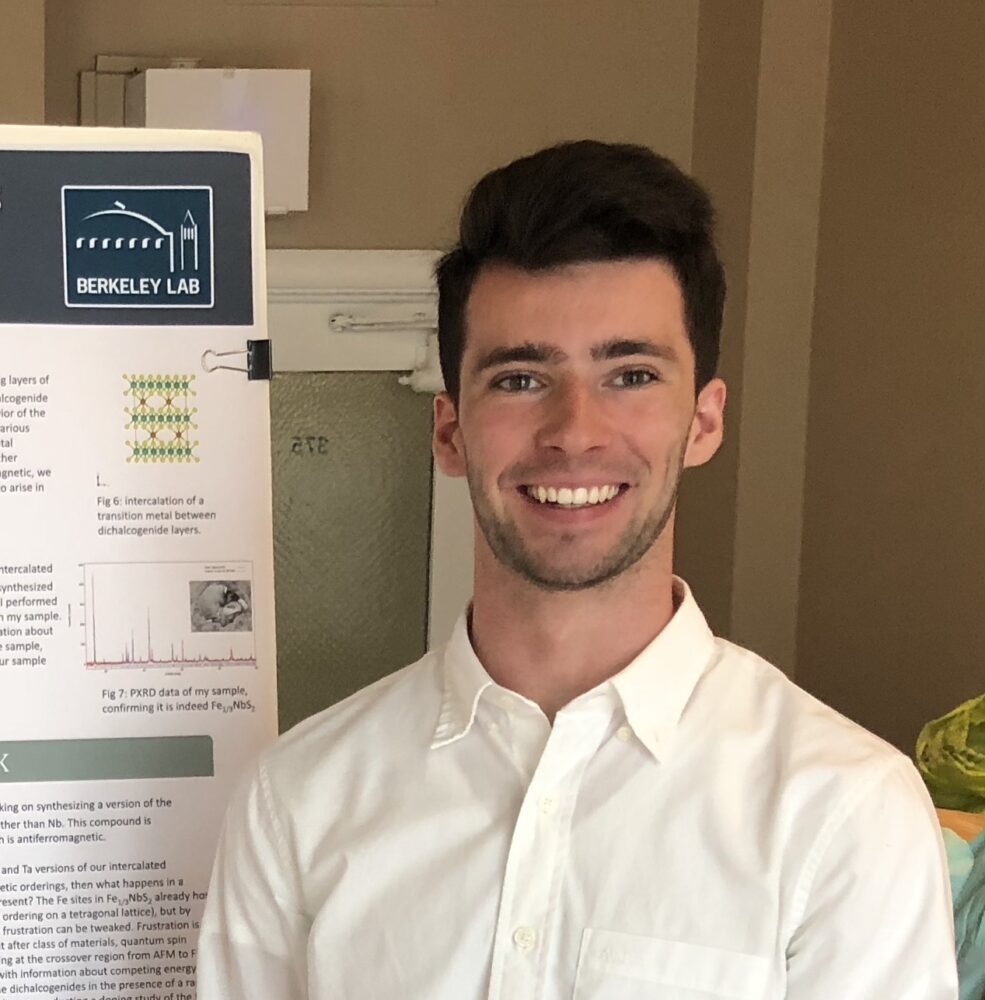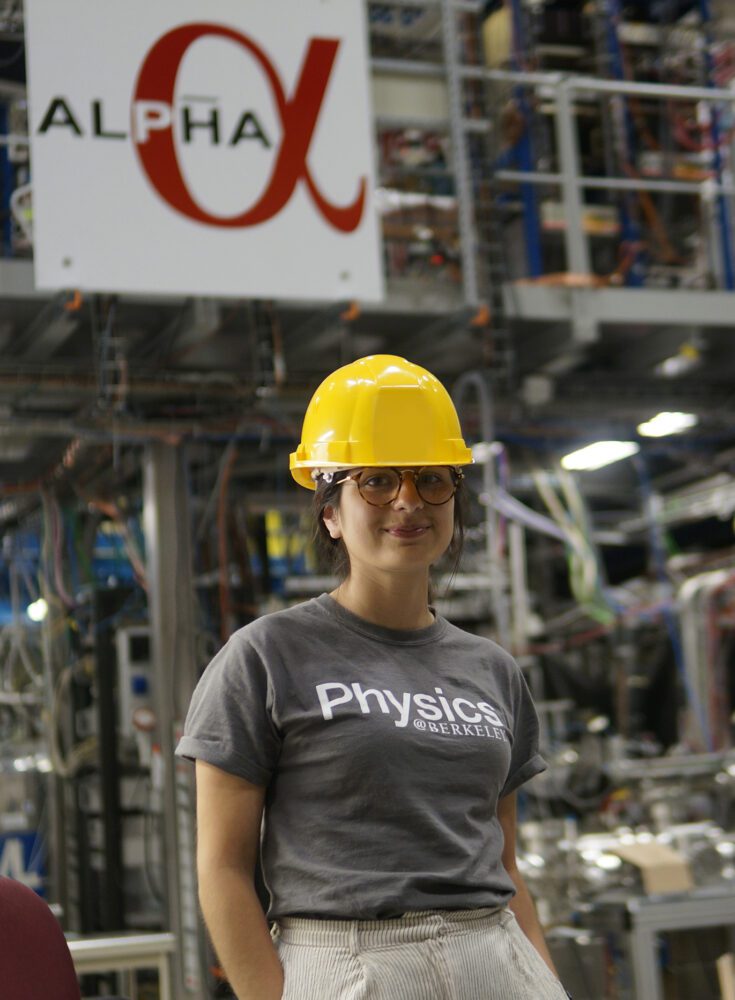Spencer Doyle

Transition metal dichalcogenides make up a class of 2D semiconductors that are of high interest in the field of condensed matter currently. I plan on synthesizing two primary intercalated versions of these compounds: Fe(1/3)NbS2 and Fe(1/3)TaS2. These two compounds have competing magnetic orderings (antiferromagnetism and ferromagnetism respectively), so what happens in a hybrid material where both Nb and Ta are present? The Fe sites in Fe(1/3)NbS2 already host frustrated moments, but by incorporating some ferromagnetic ordering from the Ta compound, the frustration can be tweaked. Frustration is one of the […]
Michael Cerda-Jara

Recently, the U.S. has seen a growing increase in the number of programs advocating for more formerly incarcerated college students. In California, the Bay Area is home to a number of these programs. One prime example, the Underground Scholars Initiative (USI), is a pioneering program located at the University of California, Berkeley that focuses on creating a pathway into higher education for formerly incarcerated individuals. As a leading institution, UC Berkeley has seen an increasing number of formerly incarcerated students graduate with a Bachelors degree. USIs first graduation ceremony was […]
Delaney Farris

Nuclear DNA is subjected to various levels of compaction, including tight wrapping around histone proteins producing densely packed, relatively inaccessible regions of heterochromatin. How nucleosome positioning is established and maintained is an area of active study. Understanding nucleosome positioning allows further understanding of proper and improper gene regulation. Budding yeast is a simplified yet highly conserved eukaryotic model used to gain understanding of complex processes that occur in humans. I am interested in studying the mechanism of silencing, using the silent mating type locus in yeast. I am curious about […]
Kristy Dang

Practice is an important process for anyone attempting to learn a new skill. Repeatedly performing the skill has been proven to lead to better learning . However, how should people organize their practice schedule if they want to learn multiple skills simultaneously? Is it more optimal to master each skill separately or all at once in a random order? There are multiple former experiments that show a random-ordered practice schedule actually leads to better retention than a blocked one. However, these studies typically use explicit motor tasks that require working […]
Dalila Robledo

According to the Standard Model, all baryonic matter is predicted to have a corresponding antiparticle. From this premise, we currently dont understand why we observe more matter than antimatter, making the study of antimatter a fascinating subject. My research project is with the ALPHA experiment at CERN, which produces antihydrogen. Composed of an antiproton and a positron bind together, antihydrogen is the matter counterpart of hydrogen. Because of its neutrality and correspondence with the hydrogen atom, it is a desirable system for experimental study. My summer project involves numerical simulations […]
Maria Krasilnikov

Listeria monocytogenes is a facultative intracellular bacterial pathogen that is being developed as a vaccine vector. The potential for L. monocytogenes as a vaccine vector stems from its ability to invade host cells and its genetic tractability, which allows us to make mutants that express antigens and are avirulent. However, it has been shown that in some instances infection with L. monocytogenes mutants causes the host to produce IL-10, which is an immunosuppressive cytokine. Thus, we believe that L. monocytogenes has the potential to be an even better vaccine vector […]
Mieko Kurata Anders
My project will explore the ideological implications of racialization through gothic tropes in William Faulkners The Sound and the Fury (1929) and Kazuo Ishiguros first two novels, A Pale View of Hills (1982) and An Artist of the Floating World (1986). Specifically, I will reframe Faulkners use of the Southern Gothic genre to configure a postwar Asian Gothic through Ishiguros early work, generating a new cross-racial, trans-historical perspective on literary representations of racial melancholia. Why, I will ask, did the historical contexts of the postbellum American South and postwar Japan, […]
William Kumler

Did you know that phytoplankton produce half the world’s breathable oxygen? These enigmatic organisms are a vital part of the marine ecosystem and closely connected to our terrestrial world, but there’s a lot we don’t know about them. This summer, I’ll be looking specifically at phytoplankton blooms – dynamic events in which they reproduce rapidly and overwhelm thousands of square kilometers of ocean – and studying the signals phytoplankton produce when stressed. This project will help us understand how carbon is sequestered in the ocean and the implications for the […]
Joseph Maa

Bacteria live in complex and diverse communities ranging from marine environments and soils to the human gut. Improving our understanding of bacterial communities is dependent on deepening our knowledge of how interactions between species affect community function and structure. In one specific interaction, phages participate in these bacterial communities by lysing members and releasing nutrients to the environment. Previous work has explored nutrient sharing interactions on larger scales and research suggests that within marine communities, in algal and phytoplankton populations, viral-mediated cell lysis is responsible for the majority of nutrient […]
Greg Pommier

Glaucoma is a leading cause of irreversible vision loss around the world. Primary open angle glaucoma (POAG), the most common form of glaucoma, arises from functional and morphological pathologies in the trabecular meshwork (TM), a band of tissue in the anterior segment of the eye that regulates intraocular pressure (IOP) by controlling outflow of the aqueous humor. In this project, I will construct a novel three-dimensional (3D) bioscaffold structure for TM cell culture that will be used to construct a TM tissue model and mimic in vivo conditions. This bioengineering […]